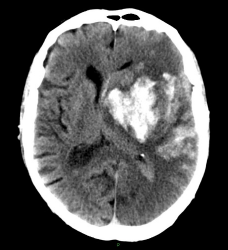
This CT scan shows extensive bleeding (white) into an area of cerebral infarction. This is known as haemorrhagic transformation of an infarct (HTI).
Monitor the patient to detect any early signs of complications. These most often occur during, or within hours of finishing, the infusion.
A baseline set of NEWS (National Early Warning Signs) observations including temperature, pulse, respirations, blood pressure, oxygen saturation, blood sugar, Glasgow Coma Scale and NIHSS should be obtained and recorded prior to starting the infusion. During the infusion monitor for changes, initially every 15 minutes for two hours, every 30 minutes for the next 6 hours and hourly for the next 24 hours but this may be varied, depending on the patients condition. Use a manual blood pressure cuff to help reduce bruising and monitor the patency of the intra-venous line during and post infusion.
Observe for signs of:
- Intracranial bleeding:
- Headache and/or vomiting
- Drowsiness
- Increase in NIHSS
- Irritability / agitation
- Seizure
- Extracranial bleeding:
- Falling blood pressure and rising pulse
- Bleeding from any orifice (mouth, rectum, nose, urogenital tract)
- Pain, bruising or swelling, especially in joints, muscles or abdomen
- Associated with any recent injury, cannulae or operation site
- Angio oedema:
- Swollen tongue or lips – The New England Journal of Medicine
- Rash
- Difficulty breathing due to airway narrowing
- Hypotension due to anaphylaxis


